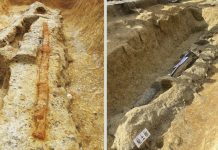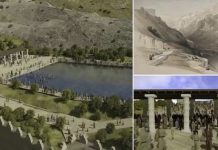Archaeologists believe they have discovered an ancient Stone Age settlement once home to thousands of people 8,000 years ago.
Today, it rests at the bottom of the North Sea having been drowned in rising sea levels after the last Ice Age.

For decades, fishers and oil exploration outfitters have reporting finding worked bone, stone, and human remains in Brown Bank, a marine ecosystem located 80 kilometers (50 miles) west of the Dutch coast.
The amount of cultural material found in the area – the submerged land, now named Doggerland – has long indicated a prehistoric settlement may have once resided here.
For the first time, researchers have confirmed two potential prehistoric settlements located on what archaeologists believe was once the banks of an ancient river.
Discovery of the ancient stone age settlement
To determine the best locations for exploration, researchers recreated the submarine landscape using data provided by oil and gas companies, wind farm developers, and coal extractors who operate in this busy waterway. Collectively, they were able to determine areas that were more likely to have been home to past human activity. Using acoustic techniques and extracting physical samples of the seabed, researchers found three sites that have the potential for archaeological and geological significance.

“This is a very exciting project to be involved in,” said geoarchaeologist Martin Bates of the University of Wales Trinity Saint David. “[O]ur job is to examine all the cores that have been drilled into the seabed and reconstruct the geology of the changing environment over the last 100,000 years. From this information, we can pinpoint likely places on, or beneath, the seabed which might have evidence for activity by our ancestors living in this now lost landscape.”
The tree possible sites
A first area likely once made up the main confluence of an ancient river system that provided central drainage to the area when ice caps melted and sea level rose some 10,000 years ago.

A second area is believed to have been a prehistoric river valley.

The last region, known as Brown Bank, is formed by a 30-kilometer (19-mile) sand ridge. Here, the archeologists found two stone artifacts that are believed to have made tools, one of which was a small piece of flint and another a larger piece broken from the edge of a stone hammer.

Further samples that show peat and ancient wood indicate that the area was once home to an ancient woodland that, when analyzed in the context of the ancient tools, suggests the area was home to an ancient civilization before being submerged.
Wow! Soon will be able to paint a real picture of ancient life in prehistoric Britain. Awesome, no?
[UWTSD, VLIZ.be, IFL Science]











